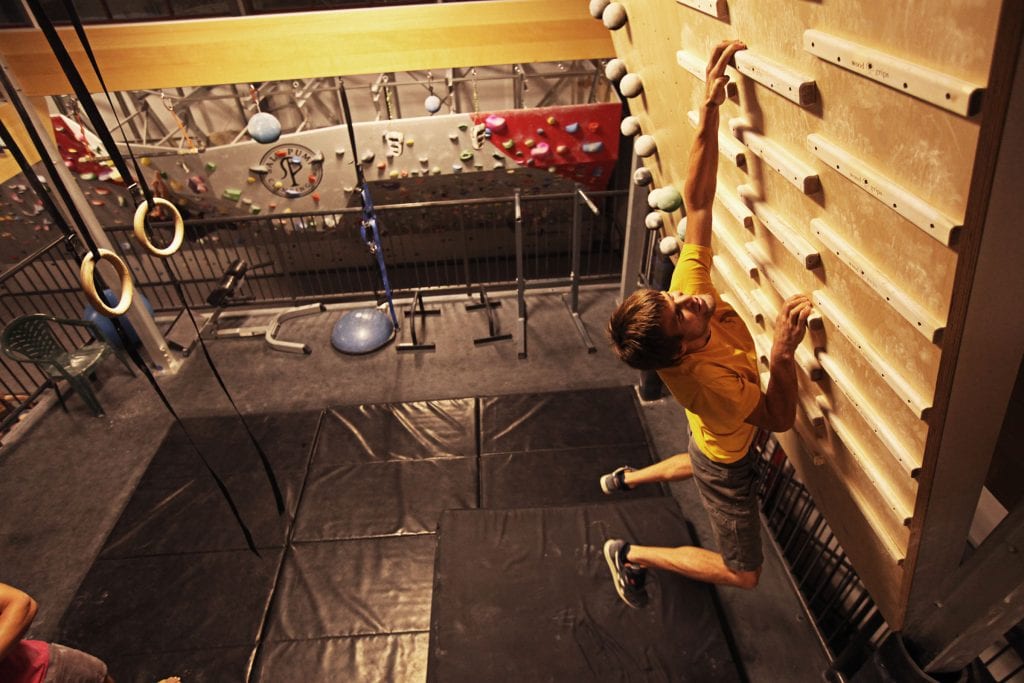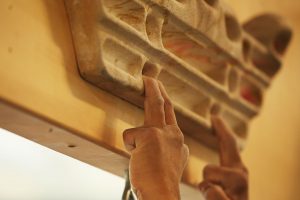Five Phases to Maximize Your Potential!

Coach Matty demonstrating “campusing” — an advanced technique to increase one’s explosive power and muscle coordination.
To normal people, when they think of climbing training, phrases like “feel the burn”, “train to failure”, “P90X” or, even better, “no pain, no gain” seem to jump to the front of their minds. While this may be the case for many sports, it couldn’t’t be more different for climbing. Abide by those phrases and they will be accompanied by a few common sounds: “pop” and “snap” seeming to be the favorites.
For many climbers, training is not something of interest or a necessity. Many people enjoy just going climbing…crazy! Others may be interested in training but would truly benefit from just more climbing, like honing in on basic technique and body movement. But for those with a solid climbing foundation that strive to push their physical limits and reach new grades, following a simple training plan could make all the difference.
I’ll start by stating that climbing is a very skill specific sport. This means that the easiest and fastest way to progress is by simply climbing…phew. Bench pressing your body weight and doing one arm pull-ups are pretty rad feats, but if words like ‘drop-knee’ and ‘flagging’ aren’t in your vocabulary than that one arm will serve you very little. However, sadly, just climbing will only take you so far. To fully maximize your potential and succeed on harder routes, issues of strength, power and endurance need to be addressed. This is where training comes into play! Get psyched!
There are loads of different structured climbing plans. The common theme in each, however, is phases. More specifically, five unique phases consisting of (1) volume, (2) strength, (3) power, (4) power endurance, and (5) performance. Sometimes these phases are completed in a linear fashion, where you will solely focus on one phase for a determined amount of training sessions. Others will take more of a non-linear approach, where you incorporate components of each phase into one training session. Regardless of how you approach your training, it’s important to keep two things in mind: (a) Stick to a structured plan—gains take time, you won’t see results over night (even over weeks), so be patient and disciplined with your training; and (b) make sure you’re increasing the intensity of your training session so your muscles will make adaptations and keep track of everything you’re doing (write it down!). Okay, still on board? Let’s dive into the components of each phase of climbing training!
Volume Phase:
The volume phase is the backbone of your climbing training plan. It provides you with the general fitness base you will need for the more intense phases to come. Volume training sessions involve lots of climbing at a very low intensity. Exercises include ARC Training, timed intervals, route circuits, and tread-wall drills. These sessions can feel long and monotonous but are a key element to any training plan. The volume phase also provides an excellent opportunity for skill development. During long ARC sessions or intervals, take time to master basic techniques and body positioning.
Strength Phase:
During the strength phase a greater emphasis is put on finger strength and whole body strength and less on actual climbing. Many would argue that finger strength is the limiting factor for most climbers looking to push into higher grades. It is also one of

Fingerboarding helps build strength in the fingers and forearms, and is considered one of the most effective training tools for intermediate and advanced climbers.
the more overlooked aspects of training. Everyone wants to come to the gym and attack their project, convincing themselves that if they keep hucking at the same move over and over again they will magically pull it off, only to fail before its time for the next boulder strip. Reality is, a lot of times, you’re just not strong enough to do certain moves and you need to take the time to address that weakness. The most common tool used to increase your finger strength is the hang-board. Through a series of planned out isometric hangs, hang-boarding can increase anyone’s finger strength. Having stronger fingers will in turn increase your endurance as you will exert less effort when grabbing smaller holds, saving that much needed energy for the heartbreaking red point crux at the top of your project. The amount of different hang-boarding regimens that exist is overwhelming, and while people will forever argue whether repeaters or max hangs are more beneficial, I think it all comes back to first rule of a training plan: follow a detailed plan and stick with it. In addition to building finger strength, the strength phase also should consist of a whole body strength component (i.e push-ups, pull-ups, dips, etc.). Again, there are loads of different protocols for whole body strength, all are great, but here’s one tip I’ll throw at you: keep the intensity high and the reps low.
Power Phase:
The power phase seems to be a crowd favorite. Finally you get to session those boulder problems! The power phase is all about making neurological gains. While the strength phase focuses on strengthening your muscles, the power phase recruits those muscles and teaches them to be more powerful. The big difference between strength and power is the function of time. Power is all about how fast you can apply your maximum strength when grabbing holds, also called contact strength. If you’re struggling to latch a big move, take a second and see if you can hold the position statically. If you can hold the position, you are plenty strong to make the move, you are just not powerful enough—as in you are not able to apply your maximum strength fast enough (i.e., power) to stick the move. The two most common ways to increase your power is through limit bouldering and campusing sessions. Limit bouldering is very different from hard bouldering. Limit boulder problems are generally 2-3 move problems that are at your absolute limit. The idea here is not to send boulder problems—if you are sending the boulders, that means they are too easy. The campus board, if used correctly, is another excellent tool to increase your power. Like limit bouldering, campus board workouts should consist of 2-3 movements. Max ladders, double dynos, and up-downs are three of the best exercises to increase your power.
Power Endurance:
The power endurance phase is where we start to transition back to a larger volume of climbing. However, the power endurance phase is very different from the volume phase. Power endurance is your ability to do a number of hard moves in a row, all of which are right at your limit. While boulderers might shorten this phase, or even skip it, the power endurance phase is critical if you want to send harder sport climbs. Workouts in these sessions would include 4x4s, linked bouldering circuits, timed intervals, route intervals, and certain tread wall drills. The power endurance phase is the final phase in most climbers training plan, and provides an excellent transition into the performance phase! You made it.
Performance Phase:
The performance phase is all about getting out and sending your projects—its time to put all of that training to use. Your efforts during this phase should be about getting outside and trying to red point routes or send boulders. Go on a climbing trip! Limit your gym sessions, and save your time and energy for your projects. You’ve worked hard to get to the performance phase, enjoy it!
How can you get Started Training?
The biggest challenge of training for climbing is getting started. Once you have your training plan all blocked out and your exercises selected, it just comes down to executing the plan. But writing up a proper training program, selecting grip positions for a hangboard phase, and figuring out how many rest days to take are all important details that can make or break a successful training program. If you are interested in training but aren’t sure how to get started, check out the new programs being offered at Salt Pump Climbing Co. Beginning this fall, we will be kicking off the first season of our Adult Climbing Team, as well as our two-week Boot Camp training session. With the guidance of experienced coaches, these programs will take you through all the phases of a training program, and help you maximize your climbing potential. The fall is right around the corner, and for New Englanders that means it’s time to get in shape for the sending season!
